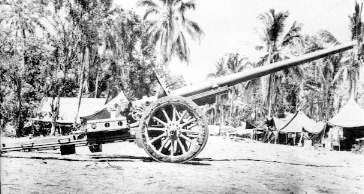Type Field gun In service 1932-1945 Designer Osaka Arsenal | Place of origin Empire of Japan Used by Imperial Japanese Army | |
 | ||
Wars Second Sino-Japanese War
Soviet-Japanese Border Wars
World War II | ||
The Type 92 10 cm Cannon (九二式十糎加農砲, Kyūni-shiki Jyū-senchi Kannohō) was a field gun used by the Imperial Japanese Army during the Second Sino-Japanese War and World War II. The Type 92 number was designated for the year the gun was accepted, 2592 in the Japanese imperial year calendar, or 1932 in the Gregorian calendar. The Type 92 cannon was intended to supersede the Type 14 10cm Cannon in front line combat service.
Contents
History and development
The Type 92 10 cm Cannon was developed from 1923-1924, as a long range alternative to the Imperial Japanese Army's existing 75-mm field artillery. Production was delayed due to technical issues, notably a desire by the Army to reduce the weight of the weapon to a minimal level, and additional requirements issued by the Army in 1927 to increase the range of the yet-to-be-completed weapon to 17,500 metres (19,100 yd). A suitable prototype was finally completed in 1932, and after extensive testing, went into production and combat service in 1934. A total of only 180 units were produced.
This piece appears to have almost completely replaced the Type 14 10 cm Cannon. It has all the standard features of the 1930-36 period of Japanese gun design. Its long barrel, short cradle, long trails, and relatively low silhouette gives it the most graceful appearance of any Japanese artillery piece. In traveling position the tube is retracted by means of a winch and locked to the cradle. The most remarkable fact about the Type 92, aside from its appearance, is the great range that it attains with a 35-pound shell in proportion to its unusually low weight. It has been reported that the weapon is rarely fired at extreme ranges, which require the use of a supercharge, because of malfunctions in the recoil system caused thereby. Some years ago troubles with the recoil system were so frequent that extra glands and packing for the recoil cylinders were carried in the firing battery, and replacing them was equivalent to first-echelon maintenance in U. S. practice. Difficulties were also reported when the weapon was fired at or near the limits of traverse. Whether this was due to a unique "bug" in the design of the Type 92 or was inherent in the use of spade-plate stabilization is not known. The Model 92 is stabilized by three spade plates for each trail. Both spade plates and trail blocks are demountable.
Design
Readily recognized by its long slender gun barrel and split carriage trail, the Type 92 10 cm Cannon was designed particularly for long-range fire. The recoil system was hydropneumatic and it had a distinctive three-step interrupted thread breechblock. It fired a 35 pounds (16 kg) shell up to14,200 yards (13,000 m) with standard high-explosive shells, and also had provision for special long-range shells that could reach 20,000 yards (18,000 m) 20,000 yards, as well as chemical, armor-piercing, smoke and incendiary shells.
The gun barrel was extremely long, making field transport very cumbersome. The gun was normally tractor drawn using its large wooden wheels with solid rubber tires, but could also be pulled by a 5-ton truck. Its greatest drawback was that it had spade plates on each trail leg that had to be pounded into the ground to anchor the gun in place.
Combat record
Despite design issues with transportability, the Type 92 10 cm Cannon was very successful and was used for long-range counter-battery and bombardment roles. It was first used in combat with the IJA 7th Independent Heavy Field Artillery Regiment at the Battle of Nomonhan against the Soviet Red Army. It later was used in the Battle of the Philippines in 1942 during the assaults on Bataan and Corregidor Island, and it was transported to Guadalcanal and used in the bombardment of Henderson Field.
Surviving Examples
A surviving gun is displayed in front of the Veterans Hall in Arcata, California. It has the serial number 136, and was made at the Osaka Infantry Armory.
